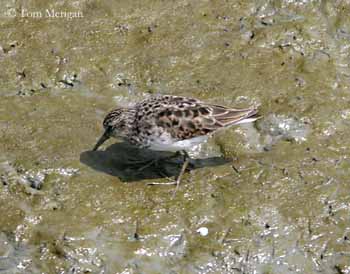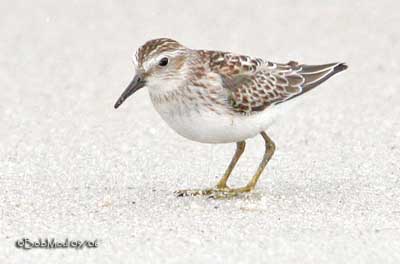
Least Sandpiper
Calidris minutilla
Charadriiforme Order – Scolopacidae Family
BIOMETRICS:
Lenght: 14-15 cm
Wingspan: 26-29 cm
Weight: 17-33 g
DESCRIPTION:
The Least Sandpiper is the smallest of the shorebirds, with slender coffee-brown body. The bill is needle-shaped.
In winter plumage, the adult has grey-brown upperparts with pale edges. The underparts are white, tinged greyish-brown on throat and breast which are finely streaked brown. The belly is white.
The supercilium is whitish. The bill is blacksih, short and thin, slightly down-curved.
PROTECTION / THREATS / STATUS:
The Least Sandpiper is vulnerable to habitat loss, increasing of human activities and disturbances, and pollution. However, its adaptation to new habitats allows hoping some stability in the populations.
The species is not currently endangered.
Fr: Bécasseau minuscule
All : Wiesenstrandläufer
Esp : Correlimos Menudillo
Ital : Piro-piro americano
Nd : Kleinste Strandloper
Sd : Dvärgsnäppa
Port : Maçariquinho
Photographers :
Tom Grey
Tom Grey's Bird Pictures
Tom Merigan
Tom Merigan’s Photo Galleries
Bob Moul
Nature Photography
Texte de Nicole Bouglouan
Sources:
HANDBOOK OF THE BIRDS OF THE WORLD Volume 3 by Josep del Hoyo-Andrew Elliott-Jordi Sargatal - Lynx Edicions - ISBN : 8487334202
A GUIDE TO THE BIRDS OF MEXICO AND NORTHERN CENTRAL AMERICA by Steve N. G. Howell, Sophie Webb - Oxford University Press - ISBN: 0198540124
GUIDE DES LIMICOLES de D. Taylor - Delachaux et Niestlé - ISBN : 2603014080
SHOREBIRDS by Peter Hayman, John Marchant and Tony Prater – Christopher Helm – 1986 – ISBN: 0747014035
THE HANDBOOK OF BIRD IDENTIFICATION FOR EUROPE AND THE WESTERN PALEARCTIC by Mark Beaman, Steve Madge - C.Helm - ISBN: 0713639601
All About Birds (Cornell Lab of Ornithology)
What Bird-The ultimate Bird Guide (Mitchell Waite)
Bird Web (Seattle Audubon Society)

The immature is similar to adults in winter, but the reddish-edged wing-coverts remind the juvenile period.
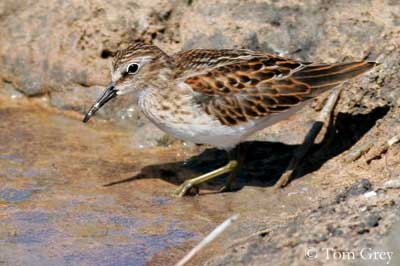
In breeding plumage, the Least Sandpiper has streaked blackish-brown crown and hindneck. Lores are very dark. The whitish supercilium is streaked dark rbown.
The mantle feathers are blackish-brown with broad rufous to bright cinnamon edges. The breast is heavily streaked dark brown. The belly is white.
In late summer, the adult becomes almost uniform on the upperparts.
In flight, we can see a narrow white wing-bar, and the white sides of rump and uppertail.
The black bill is thin and slightly down-curved. Eyes are dark brown. Legs and feet are yellow.
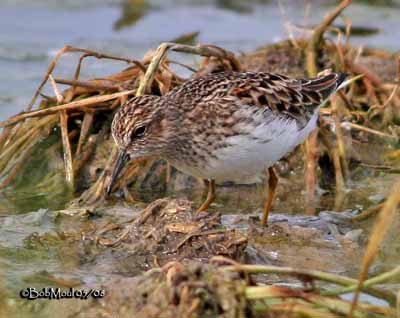
VOICE: SOUNDS BY XENO-CANTO
The Least Sandpiper’s typical call is a high-pitched, rising shrill “trreee” given in slow series, and a low “prrrt”.
It utters monotonous song during the aerial displays or when on the ground, a single, repeated note.
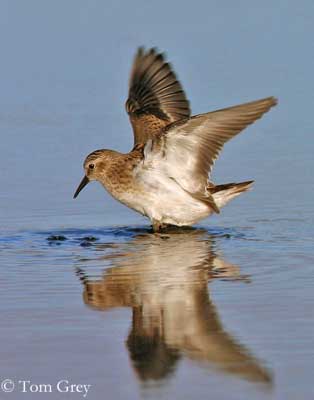
HABITAT:
The Least Sandpiper breeds in open tundra where it can find water, in wet areas close to mudflats and marshes with forested shores.
Outside the breeding season, it prefers muddy fresh or brackish waters and marshes. We can also see it on the shores of estuaries, but less frequently on sandy beaches.
RANGE:
The Least Sandpiper is native from North America. It migrates in flocks of 10 to 100 birds through North American continent to winter in southern United States and in northern South America.
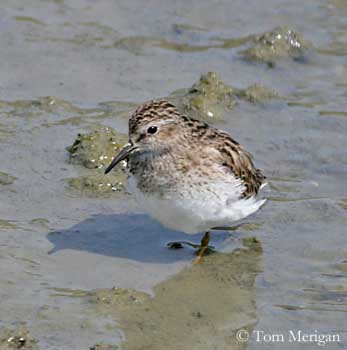
BEHAVIOUR:
The Least Sandpiper feeds in the mud by crouching and probing, and wades in shallow water with upright stance making it taller. It probes and pecks from the water surface. It forages by walking slowly with lowered head, catching its preys from the surface, but also by probing in the moist mud with the bill.
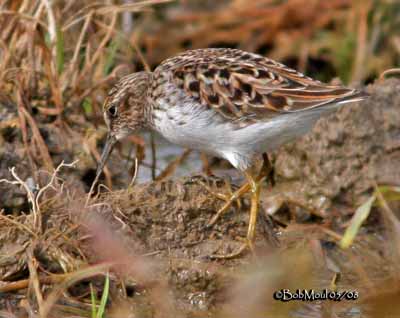
This species is seen alone or in small groups. Usually, it forages on the high mudflats’ shores, often into the vegetation.
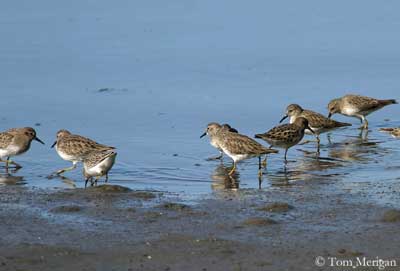
The male defends the territory by singing continuously during the flight displays. The species is monogamous for the season, sometimes for longer time.
FLIGHT:
The Least Sandpiper performs fast, direct flight with rapid wing-beats.
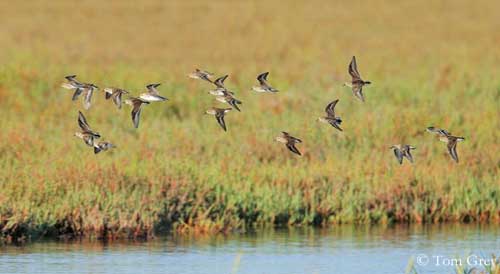
REPRODUCTION:
Breeding season occurs in spring, with the laying between mid-May and early June.
The Least Sandpiper male arrives one week before the female and establishes the territory. The monogamous pairs form as soon as the female has arrived.
The nest is on the ground, close to the water, usually in clump of grass or moss. The male makes a shallow scrape and the female lines it with grasses, leaves and moss.
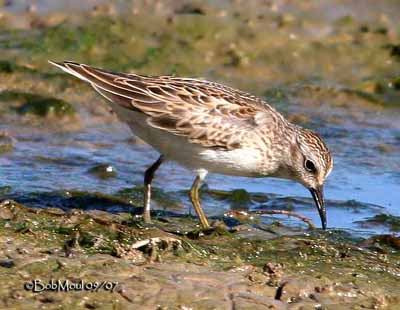
Then, she lays 4 brown eggs with dark pink or pale buffy-olive markings. The incubation lasts about 19-25 days, shared by both parents. Little by little, the male takes part in nesting duties while incubation is in progress.
The chicks leave the nest less than 24 hours after hatching and are able to feed themselves. Their parents brood and rear them, and usually, the male remains with them until they fledge, three weeks after hatching.
When a late brood occurs, the female may leave before the hatching, but usually, she helps the male to rear the young at least for the first week.
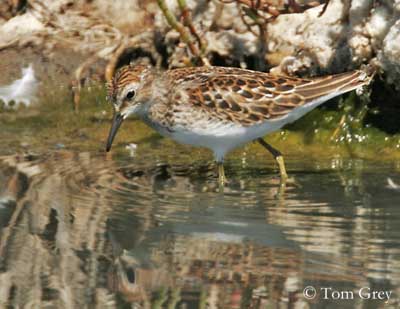
DIET:
The Least Sandpiper feeds on aquatic insects, small crustaceans, molluscs and worms.
